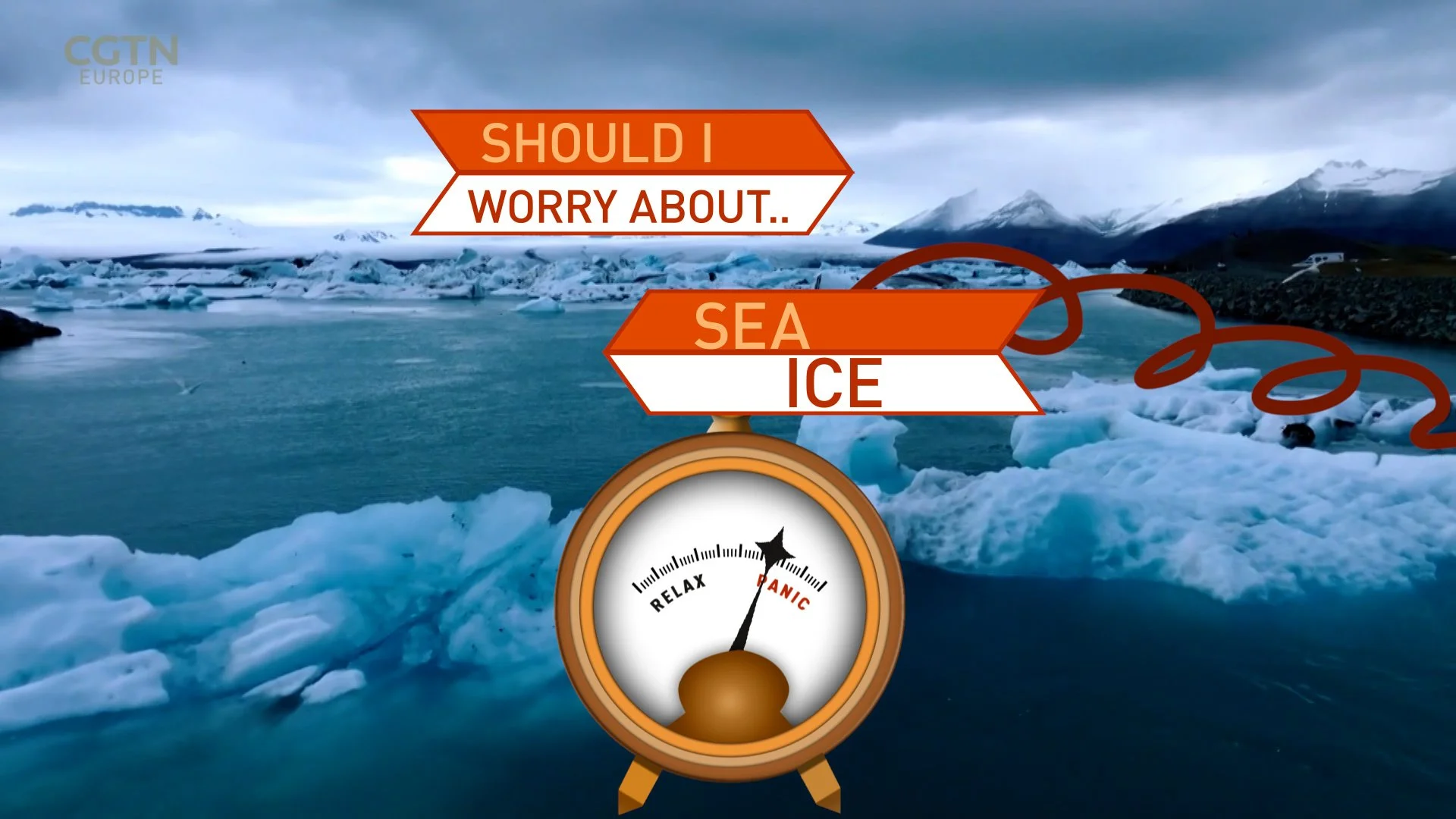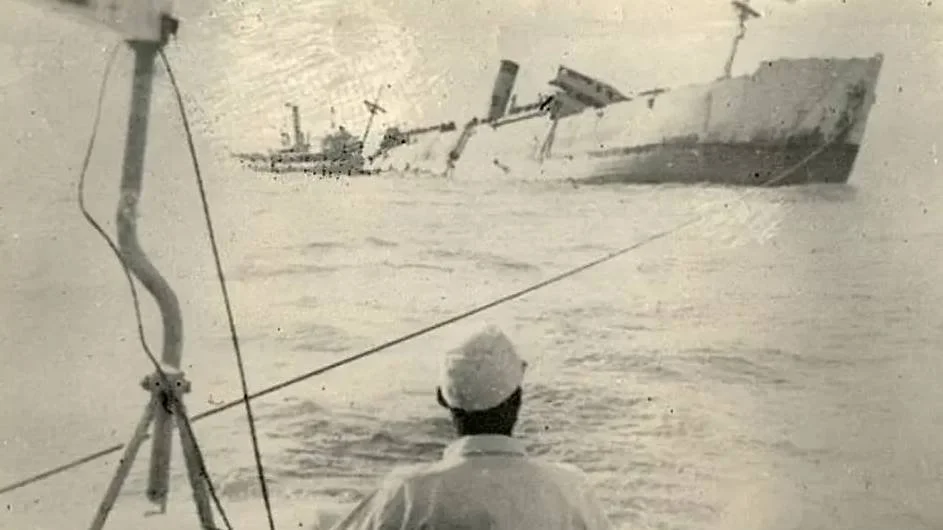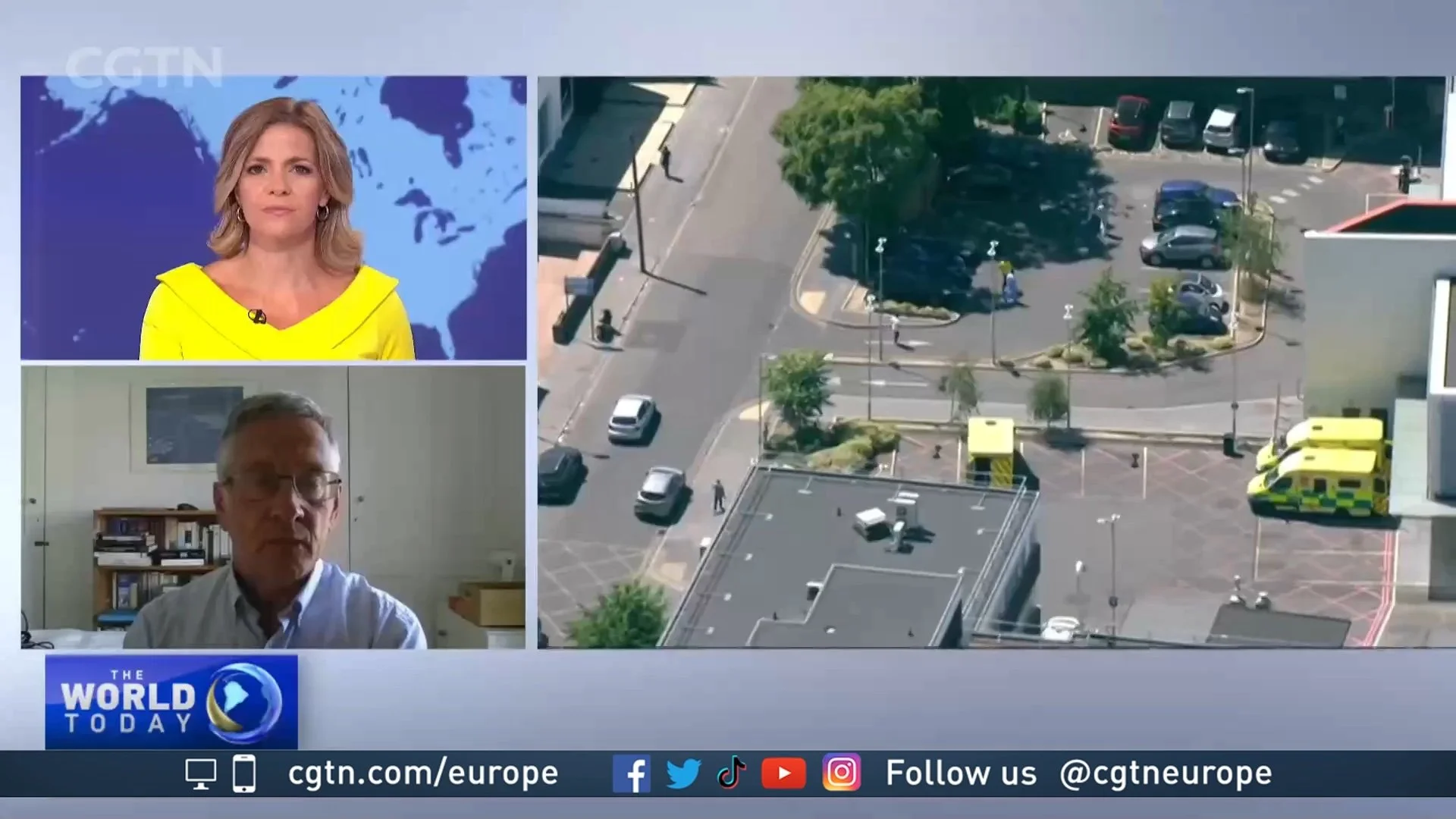Should I Worry About... Melting sea ice?
What is sea ice?
That's an easy one – sea ice is frozen ocean water. But the trouble is, it's not freezing as fast, or as much, as it used to – or as it needs to.
Sea ice provides an ecosystem for various species up to and including the polar bear, that poster child for the effects of climate chaos on the ecology. But it also plays a key role in planetary temperature modification.
Sea ice is, as you can imagine, a large expanse of white reflective material: polar explorers don't wear dark glasses to look cool. That brightness is reflected sunlight, and sea ice plays a crucial role in bouncing solar rays back out into space. When there's less sea ice, the Earth absorbs more solar heat – raising global temperatures, which in turn can lead to more ice melt.
"There's this thing called Arctic amplification – the Arctic is warming faster than anywhere else on the planet," Melinda Webster tells CGTN. An expert in sea ice, she works at the University of Washington's Applied Physics Laboratory Polar Science Center – and she's worried by what she sees.
"For sea ice in particular, one of its superpowers is just how incredibly reflective its surface is" – a measure known as its albedo. "To give you some numbers, about 70 to 80 percent of sunlight is reflected back into space from sea ice. But the ocean only reflects about 7 percent. If you remove that highly reflective surface, there's a lot more sunlight that's going to be absorbed by this darker, open ocean."
Much of this has been seasonally cyclical – remember, the polar circles are by definition where the sun never sets in the height of summer and never rises in the depths of winter. But the problem is worsening – all year round, and at both ends of the planet.
"The Antarctic sea ice, which kind of withstood the warming trend, is actually retreating at a very fast rate," says Petra Heil, a senior research scientist with the Australian Antarctic Division. "In the last two austral [southern-hemisphere] summers, we've seen sea ice coverage has substantially retreated. So there's less ice surviving through the season and surviving into the next winter, and that's having a lot of ramifications."
How do we know it's getting worse?
"We typically look at daily composites, and we can clearly see that at the moment the sea ice extent is well below typical standard deviations," says Heil. "We're talking typically in our science about anomalies – that means relative to a standard reference period. In our case, that's a 30-year period towards the beginning of the satellite record from the 1980s to 2010. It's quite a dramatic drop this year and last year compared to the 30-year reference period that we measure our numbers against."
Webster is more blunt. "I would say there's some pretty profound changes happening right now – the unprecedented loss of Arctic sea ice and Antarctic sea ice. The coverage and the thickness of the ice are both in decline, and this is happening at a rate that hasn't been observed before."
Scientists are dogged, accurate types who record and analyze numbers. They're worried by the results they see, but more often it's pictures that catch the public imagination, and the problem is summarized by images of polar bears on ever-shrinking ice.
"There's been some pretty common projections by climate models showing that we can anticipate an ice-free summer in the Arctic by the 2050s or 2060s," says Webster. "And the models are underestimating the rate of sea ice loss, which is scary."
Heil agrees. "We need to revise our forward estimates, which are largely based on models. Updated with recent observations, a sea ice-free Arctic Ocean or dramatic loss of Arctic sea ice happens much earlier, decades earlier, than we were able to forecast five or 10 years ago."
And the numbers keep rising. In mid-July 2023, the World Meteorological Organization (WMO) reported that Antarctic sea ice levels reached record lows the previous month, at 17 percent below average.
"We're used to seeing these big reductions in sea ice in the Arctic, but not in the Antarctic. This is a massive decrease," said Michael Sparrow, Chief of the WMO's World Climate Research Programme.
"It is not only the surface temperature, but the whole ocean is becoming warmer and absorbing energy that will remain there for hundreds of years," WMO said. "Alarm bells are ringing especially loudly because of the unprecedented sea surface temperatures in the North Atlantic."
Is it just a problem at the poles?
Not at all. As Webster puts it, "What happens in the Arctic doesn't stay in the Arctic." The Earth is a huge, complex system, and changes in one part of it can have a large effect elsewhere.
This is not a metaphor or theory, like the "butterfly effect" proposed when mathematician and meteorologist Edward Norton Lorenz suggested that the path of a tornado could be affected by a lepidopteral wing-flap weeks earlier. Instead, this is the known and measurable science of atmospheric circulation.
"People in the northern hemisphere have noticed that storms are more variable and more intense," says Heil, and that can be blamed on the breakdown of the polar vortex – a large region of cold, rotating air, poleward of the jet stream.
When it's strong, the polar vortex remains relatively self-contained – but as it weakens, the cold polar air can drift toward the equator, bringing notable and often perilous drops in temperature. Among the effects have been several cold winters in the U.S. and flooding in the UK.
"A breakdown of the [Arctic] polar vortex has been noticed," says Heil, "and the analog has been happening in the Antarctic – a polar vortex centered just off the Antarctic continent used to be much stronger."
Meanwhile, that melting sea ice is also having a more direct effect on the planetary system.
"Now we see changes in that atmospheric circulation and that links down directly to the sea ice, via transports – what you see as it's moved by changes in the wind system and similar," says Heil. "The ocean responds to those changes and they enforce a step change from the bottom together.
"The sea ice is also responding to changes – for example, by biology. If you have biological activity on the sea ice, it will discolor from its usual bright, light color to something darker." That reinforces the albedo effect mentioned earlier: by being less reflective, it helps temperatures increase.
What's the worst that can happen?
"There are several effects that we're already seeing from climate change and from sea ice loss both in the Arctic and Antarctic," says Webster. "One thing to think about is the change in the environment.
"We're taking away this ice cover and there's many species that are dependent on that ice cover, whether it's the phytoplankton which build the base of the marine food web or polar bears as the apex predators. They're having a really difficult time surviving because they're essentially having a habitat loss."
Webster calls this "a shift in a species distribution that has real-world implications for fisheries, for marine activity, marine traffic." And there are other knock-on effects: "changes in the jet stream, which can then change storm tracks. Things like that are active areas of research, but there are these linkages that occur."
Whether the links are weak or strong, Webster sees them as part of the planetary package.
"There's a lot of different ways that climate change can manifest into things that we experience. These cold air outbreaks in winter time, those may become more prevalent. To say that there was an extreme storm today is directly related to sea ice loss – that's not as strong of a connection, but the pattern of consistently more storms and more intense storms is something that is attributed to climate change."
Worriedly eyeing the Antarctic, Heil sees the potential for huge change: "The less sea ice you have, the more freedom the Antarctic ice sheet has to slip off immediately, because there is no holding it back through a 'belt' of sea ice, as we refer to it. That's the immediate worry, especially for communities with infrastructure near sea level. Some low-lying island states would obviously be affected by that.
"But we also see that different marine organisms, from the very simple to the higher trophic levels, will be affected because the production of primary nutrients within the ocean will be affected and the food chain will pick up on that. If there is less food available at a lower trophic level, that affects the whole food chain.
"We've lost a large number of species of biosphere – biodiversity reduction. We've seen living conditions on earth for animals and for humanity decrease. Our lifestyle is not maintainable and if we want to work towards maintaining our lifestyle, we have to spend a lot of fiscal resources towards it and that's not sustainable.
What can we do?
Some problems have mystifying origins, while others have obvious sources – even if it doesn't necessarily make change any easier.
"It's basically all a function of the increased CO2 into the atmosphere and into the ocean by increasing human activity, and that directly can bring warming," insists Heil, and Webster lists off how we can change that.
"It's critical to reduce our greenhouse gas emissions to mitigate further warming. It's critical to give future generations a fighting chance to mitigate the negative consequences of climate change. And foremost, it's about greenhouse gas emissions – reducing those and reducing the current level of greenhouse gas concentrations in the atmosphere is important.
"Trends in warming are going to be larger in some areas, and those areas are where many people live. And it's going to be a fundamental change to people's lifestyles and what they experience in a quality of life. So is it critical? Absolutely. If we want to have foresight and care about future generations, it's absolutely critical to make these changes."
Species which have evolved for certain conditions may find themselves under threat. /Reuters
Heil splits the task into phases – "First we have to undertake a lot of measures to slow down the rate of increase, and then to level it, and then we can think about a reduction" – and furthermore, into two spheres of activity: the personal and the political.
"You have to work very hard at two levels. At the individual level, we have to be cognizant of what we can do and we have to actively do it. It needs education for individuals and it needs recognizance that probably our lifestyle will be less comfortable, less convenient, and that there will be a financial and other costs associated with it.
"Together with that, there need to be national and international policies that we subscribe to as nations, as Earthlings, to really work together to rein that in. We need improved policies that guide us nationally, but also internationally to aim at preventative measures in reductions in CO2 emissions, to adopt different lifestyles that are not dependent on carbon energy. We need to go to carbon neutral energy sources."
The situation is exacerbated by the conflict between Russia and Ukraine limiting vital Arctic monitoring.
"There are usually international field campaigns where people from many nations join together to bring the best instruments, the best methods, and collect the best possible data," explains Heil. "From the colleagues that I've talked to, they cannot at the moment access, for example, autonomous information that's moored near the bottom of the ocean or deployed somewhere on the sea ice."
Is it happening?
"Arctic coastal communities are absolutely at risk – several have already had to be relocated because of coastal erosion and sea level rise," says Webster. "So there are places that are already getting directly impacted by climate change at this stage."
But the effects will soon spread south. "In Denmark and places in Germany they're extremely vulnerable to sea level rise. And there's also the factor of coastal erosion."
Perhaps bringing the focus closer, into heavily inhabited areas, will help the public make the leap from the polar bear to the front doorstep.
"It's about thinking of the future of humanity and having empathy about what the future is going to look like for everyone if we care about the quality of life of future societies," pleads Webster. "This is something that we need to change now.
"I do believe that everyone feels strongly about the quality of life that we have now and what future generations will have. But it's not going to be as good if we don't act now. It's critical to make these steps now to reduce greenhouse gas concentrations. It's absolutely critical for health, quality of life and education, all of these things that are meaningful to people's lives."
Heil worries that the message isn't getting through.
"My personal concern is that the message of the urgency that we need to act now collectively is not taken seriously enough," she says. "The WMO and the UN are very outspoken, very often on the front foot with the messages they give out. I really compliment them on doing that and also spreading them with a large range of media."
A changing environment threatens all manner of species... including humans. /Reuters
For Heil, the problem comes at a national level, with politicians – often facing imminent elections – worried about short-term problems and balancing budgets.
"National leaders are very much confined by what they can do to have financial resource limitations," she says. "Some implementations will incur a startup cost, which might be significant rather than just to keep going on our current strategies.
"For example, switching out energy resources to carbon neutral sources, you need to make an investment, just like any time you change from one system to another."
Webster at least detects more public concern than at some points in the past.
"There has been a change in the willingness to listen. It wasn't that long ago that it was debated that climate was changing, and now there's a general acceptance that, yes, it is changing. And I would like to think that most are also accepting that it's anthropogenic climate change, not just natural climate change."
There may still be those who bicker with the science, or query the cost – but Webster insists they will soon be drowned out by evidence and events.
"Regardless of whether people want to listen or not, they'll have to listen – because it's going to be such a dramatic change in the future if we don't act now."
Interviews by Elizabeth Mearns. Originally published by CGTN Europe, 5 Aug 2023






